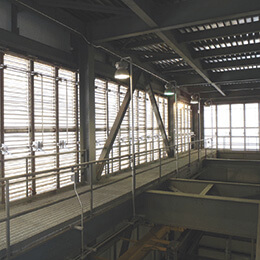Project Profile: Basin Electric Power Cooperative

The Challenge
• Create highly functional large louvers and dampers with no vertical sight lines
• Design dampers with special jackshafts and drive arrangements
• Louvers and dampers must sleeve together and withstand high wind loads
• Design louvers and dampers to fit around angular bracing, cross bracing and structural beams
• Louvers and dampers need to be hoisted and installed 300 feet above the ground
Basin Electric Power Cooperative (Basin Electric) is one of the largest electric generation and transmission cooperatives in the United States and a parent company of eight subsidiaries. Basin Electric's newest facility is the Dry Fork Station, a 385 megawatt coal-based electric generation power plant near Gillette, WY that will meet the long-range power needs of its 135 member cooperatives. The total output will provide enough electricity to power more than 308,000 homes. Ground breaking occurred in November, 2007 and the plant was placed in commercial operation November 1, 2011.
EAPC, the engineering firm, specified dampers and louvers to draw in outside air for cooling purposes, but also wanted to use a continuous blade profile on the exterior louvers to eliminate vertical sight lines and to project a clean, efficient appearance for the massive plant. Engineers had to design louvers to withstand high wind loads because the louvers would be installed near the furnaces 300 feet above the ground where higher wind loads occur. Larger single louver sections were requested to simplify installation.
Due to the scope of this project, all vendors, materials, drawings and delivery schedules were required to use a software program called Constructware. All submission drawings, phone conference records, emails and final approval drawings had to be sent through Constructware. Individual tags numbers were required for all louver/dampers, even when the identical units were called out on elevations.
Greenheck’s Solution
• (932) Airfoil Control Dampers
• (263) Stationary Extruded Louvers
• (4) Backdraft Dampers
Greenheck designed the louvers with a damper sleeve on the back. The louver /damper units were mounted on the outside of the building and were required to have a seamless look. Approximately 85% of the louvers were oversized - some weighing as much as 1200 lbs. Due to the high wind and design loads imposed, a 1/4 inch aluminum sleeve was incorporated all around the damper and this sleeve was mechanically fastened to the back of the louver. This unit was then anchored to the structure by tabs that were fabricated into the damper sleeve at the head and sill. A 1/4 inch stainless steel lifting lug was designed and applied to each jamb of the louver unit at the head so a crane would be able to lift the louvers in place. One of the more difficult challenges in designing around the structural beams was the special jack shafting that was required for the dampers. To support the sleek, attractive appearance of the new facility, a standard Kynar® two-coat finish of White Dove and Sky Blue was applied to the louvers. A lot of coordination was needed between the damper and louver engineering team to ensure that component tag numbers precisely matched.
The Results
By using Greenheck, the customer got the seamless look that they were looking for, as well as the satisfaction of finishing the project on time without any change orders. Greenheck engineering was extremely flexible and responsive to the special needs on this project.
There have been no issues with the louvers being able to handle the high design loads.
"The construction of the Dry Fork Station is an extremely complicated project," said Dennis Thorfinnson, plant engineer at the Dry Fork Station.
"We worked closely with all of our contractors to make sure each phase of the plant was completed and operating as it should".



